

Many feature customizable arrow-management systems and a small pocket for extra gear. They’re typically made of leather or synthetic fabrics, and they’re easy to pack in your bag or bow case. Clip them to a belt loop or onto your belt. You’ll need to count your arrows as you shoot or turn to identify numbered arrows.įield quivers are the traditional hip quiver. One downside of field quivers is that you can’t conveniently see which arrow you’re grabbing without looking behind you. Instead of reaching in front of you, however, just reach behind. Grabbing an arrow from field quivers requires a short, simple motion similar to that used with target quivers. “I did this so the arrows wouldn’t hit the person behind me when standing on a very tight shooting line, as often happens at indoor tournaments,” Harrelson said. Harrelson prefers her arrows to lean backward like those in a field quiver, but she customized her quiver to reduce the angle. In that position, arrows catch on branches less often. If you enjoy field courses or 3-D ranges that snake through woods, consider using a field quiver, which is basically a target quiver that leans the fletching backward and the points down. They’re usually made of leather or synthetic fabrics. They also have three to four built-in plastic tubes that separate your arrows. As with field quivers, target quivers hang off the hip with a clip or belt. Target quivers, however, offer more storage pockets and clips for accessories and tools. “I’ve always felt this style quiver was more likely to interfere with a shooter standing in front of me,” Harrelson said. They also tend to stick out in front, which can be inconvenient during competitions. She notes that target quivers can sway and hit your side more so than field quivers as you walk at 3-D or field shoots.
#Best recurve quiver pro#
What’s their downside? Christine Harrelson of Christine Harrelson Archery is an archery pro and instructor. Grabbing arrows from target quivers requires just a quick reach to your side. If you shoot a variety of arrows or number them, target quivers are ideal. That makes it much easier to see and sort through your arrows. Target archers who like hip quivers often go for target quivers, which lean the arrows’ fletching forward and their points down. Hip Quivers: Target quivers, however, offer more storage pockets and clips for accessories and tools.

You must also choose between two types of hip quivers: target and field. The main difference between hip quivers and back quivers is that one hangs off your hip while the other hangs across your back. If you want a quiver that’s portable, detaches from your bow, and carries many arrows, a hip or back quiver might be the best fit.īut which quiver type should you choose? Like most wearable gear, quivers come in different looks and styles. Cue the quiver, the accessory that holds your arrows. Whether you bowhunt or shoot target archery, you want quick, easy access to your arrows.


 0 kommentar(er)
0 kommentar(er)
